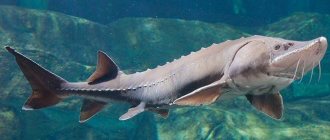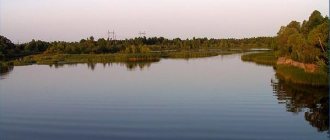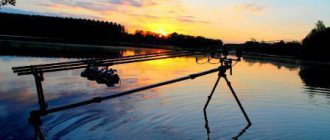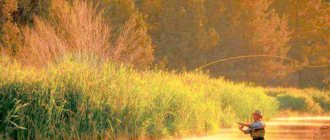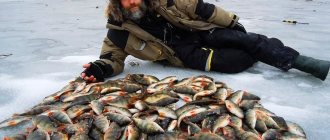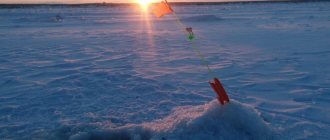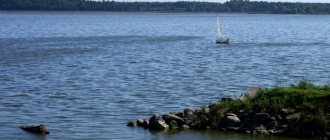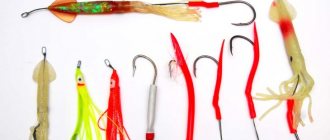For many spinners, floaters and feeders in the Middle Zone, fishing on the Eel is an exciting and very interesting activity. With a length of almost four hundred kilometers, this large river of the Volga basin is rich in fish stocks, picturesque places for recreation and fishing with various tackles.
This article will talk about what this river is like, what types of fish are found in it, where the best fishing spots are, what gear is best to use on them.
Description of the river
The Ugra is a large and deep left tributary of the Oka, originating on the Smolensk Upland near the village of Babichi. Flowing through the territory of the Smolensk and Kaluga regions and having a length of 399 km, it flows into one of the largest rivers of the Volga basin not far from Kaluga, near a small village of the same name.
Due to its geographical location, this river is called the “Belt of the Virgin” - during various wars this watercourse was a natural obstacle for enemy troops.
The Ugra is a typical lowland river with a mixed type of feeding. The main sources of river replenishment are (percentage of annual flow):
- melt water – 60%;
- summer rains and underground groundwater coming to the surface in the form of springs and cold springs - 35-40%.
The river has 60 tributaries with a length from 2 (small river Rosvyanka) to 388 km (river Ugrichka).
The maximum width of the channel part in the lower reaches reaches 80-90 m. The river has a wide variety of depths. Thus, within wide reaches there are quite large 4-5 meter channel and bank ditches, while on numerous rifts the river has an average depth of no more than 0.6 m.
Important! Due to the fact that the bottom and banks of the Ugra riverbed are composed of sand and small pebbles, the depths in some places change very often. This happens due to the erosion of the bottom and the erosion of the banks by a current that is quite fast for a flat river. This feature is very important to take into account not only for fishermen, but also for tourists relaxing on its shores - very often in those places where a year ago you could safely swim, deep and very dangerous holes with whirlpools appear.
What types of fish live
There are more than 20 species of fish in the river. Of the peaceful species, the most numerous are representatives of the Carp family such as bream, ide, chub, roach, bleak, and dace. Large golden crucian carp, rudd, and tench are found in the backwaters and oxbow lakes. Among the predatory species in the Ugra River there are pike, perch, pike perch, asp, and burbot. Large catfish are found in the lower reaches
Among the species living in the Ugra there are such rare ones as sterlet and Caspian lamprey. Listed in the Red Book, they are under state protection. When catching these fish, they must be carefully removed from the hook and released without causing harm. If such fish are found in a cage by an environmental inspector, the fisherman will be brought to administrative or criminal liability (depending on the amount of damage caused to nature).
Fishing places
The most visited and fish-rich places are the following sections of the river:
- near the city of Yukhnov (Yukhnovsky district, Kaluga region);
- Ugra and its tributaries within the boundaries of the Yukhnovsky district;
- the confluence of the Ugra and the Oka 12 km west of Kaluga;
- the confluence of Ugra and Zhizhaly a few kilometers from the village of Bazulino (Temskinsky district, Smolensk region);
- a section of the Ugra southwest of the village of Kikino at the confluence of the small river Ugorskaya.
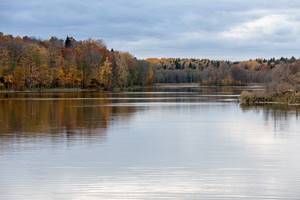
The Ugra upstream of the city of Yukhnov is one of the most fishing places on the river
The various oxbows and bays of the river located in its middle and lower reaches are also very rich in fish.
Ugra River. Winter Donka. Fishing Report | Photo and video
Author, Konstantin
February 9, Ugra River. Finally decided to give myself a day off and went fishing for the whole day. As always, I don’t sleep well before fishing, so I decided to go early. As they say: it’s better to be in the dark on ice than to suffer tossing and turning in bed.
At 7.30 I was already on the river, looking for a promising place for fishing. I put on a small jig, silver in color, add a bloodworm and off we go. Immediately on the 1st hole I take a small perch and sink it back, it’s too small. Next came a small roach, and that was all, it became quiet.

Since there is a perch in this place, I decide to drill a little with several holes in different directions. I bet the fool and went through the holes. I didn’t have to walk for long, on one hole, I almost immediately got a bite, and the perch was already on the ice. As a result, the perch bit like a machine gun, but its size left much to be desired. Almost everyone had to be released, only a few were left behind.
Still, I’m starting to get tired of catching such little things, and I decide to change my location. Meanwhile, the ice is already becoming quite crowded, the fishermen are increasingly arriving at dawn. I move a little upstream, visually identify the backwater and the storm for several holes. Before I had time to lower the bait, I immediately received a sharp blow to my hand. Now this is interesting. I get a good perch and feel my mood improve.

3 ways to improve your fish bite!
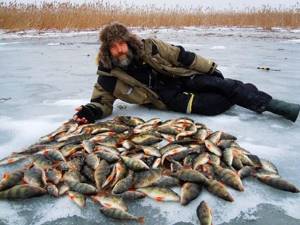
Over 15 years of active fishing, I have found many ways to improve the bite, and here are the most effective:
1. Bite activator . This pheromone additive attracts fish most strongly in cold and warm water. The Fish Hungry bite activator has proven itself to be excellent - Read more…
2. Tackle with increased sensitivity . You should first familiarize yourself with the features of using a particular type.
3. Pheromone baits . They attract the attention of fish, stimulate hunger and cause a schooling reflex, which allows you to collect a lot of fish in one place.
You can get the rest of the secrets of successful fishing for free by reading my other materials on the site.
3 ways to improve your fish bite!
Over 15 years of active fishing, I have found many ways to improve the bite, and here are the most effective:
1. Bite activator . This pheromone additive attracts fish most strongly in cold and warm water. The Fish Hungry bite activator has proven itself to be excellent - Read more…
2. Tackle with increased sensitivity . You should first familiarize yourself with the features of using a particular type.
3. Pheromone baits . They attract the attention of fish, stimulate hunger and cause a schooling reflex, which allows you to collect a lot of fish in one place.
You can get the rest of the secrets of successful fishing for free by reading my other materials on the site.
In total, at this place I caught about 10 good perches. After that, the bite suddenly died down. I decide to radically change my fishing tactics, and perhaps the type of fish I catch. Buryu, a little further from the shore, on the course of 2 holes, with a distance of 1.5 - 2 meters between them. I mix the bait with the addition of food bloodworms, and lower the feeder into the hole, which is located upstream. Secondly, in the second hole, which is located downstream, I lower the bottom with a load, using a worm as a bait, along with a bloodworm.
I didn’t even have to wait for a bite, they came right away! And so for 40 minutes, mostly roaches and silver bream were biting. I was already thinking that the bite would never end, but alas, as soon as I thought about it, the bite was cut off. After that, I decided to run through my old and new holes with a jig. But apart from the ruffs biting, I didn’t see anything else.
The time was already approaching the end of fishing, and I decided to slowly get ready. I had a great rest, the Ugra River made me happy! I caught a good variety of fish. There are photos and videos. Thanks to all.
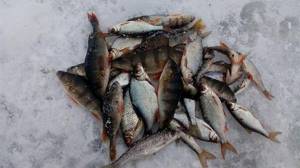
Tackle
Due to the wide species diversity of ichthyofauna on the Ugra, the following gear is used:
- Fly fishing - this gear is used to catch chub, asp, large roach, and podust on the riffles of the upper and middle reaches of the Ugra.
- Spinning - in the upper reaches of the river, in areas with a small width of the channel, light ultralight and light tackle is used, consisting of a rod 210-220 cm long with a dough from 0.5-10 to 8-10 g. In the middle and lower reaches, where the river becomes wide and deep, they use coarser tackle - a spinning rod 220-240 cm long with a dough from 8-10 to 30 g. The baits used are twisters, vibrotails, silicone creatures (crustaceans, octopuses, etc.), spinners, wobblers.
- Float tackle - in the upper reaches they use a short 4-5 meter light Bolognese fishing rod with a small reel, a light float with a weight of up to 1.5 g. In the middle and lower reaches they use more powerful tackle, consisting of a 5-7 meter rod with a spinning rod reel, monofilament with a cross-section from 0.16 to 0.22 mm. In backwaters, bays and oxbows they use a five-meter fly fishing rod with a blind rig, consisting of a 4-5-meter piece of main monofilament fishing line with a cross-section of 0.14-0.16 mm, a small float with a load of 0.7-1.0 g.
- Feeder - an English bottom fishing rod is used for catching large bream, roach, ide, and silver bream on the reaches of the middle and lower reaches of the Ugra. For fishing on the stretches, suitable gear consists of a rigid feeder rod 360-390 cm long with a dough from 60 to 100-120 g.
- Live bait gear - for catching perch and pike, they use circles and coastal girders.
In winter, on the river and its backwaters they fish with jigs, vertical spoons, and a balance beam. In the riverbed part of the lower reaches of the Ugra they use tackle for fishing with a pull (pull), a winter feeder.
Attention! Live bait gear used for catching predatory fish species is using stakes and under-ice traps.
Fishing Features
As already mentioned, a significant part of the river basin is located on the territory of the national park of the same name. Wonderful fishing on the Ugra is known far beyond the region. There are large areas of reservoirs where there are no settlements. Water travel on rafting vessels is very popular here. There is no navigation on the river. The most popular fishing is for predatory fish. Taking into account the size and conditions of the river, fishing can be quite varied and exciting. It is better to look for carp species such as bream, bluegill, and common carp in the lower reaches of the river. In the upper and middle reaches shallow depths predominate; on rapids you can more often find asp or chub. Along with the most popular spinning fishing among Russians, Ugra is an excellent “testing ground” for fly fishing. Along with summer fishing on the Ugra, winter fishing is also popular. When traveling to the Ugra River for the first time, we recommend using the services of local holiday organizers. Especially if you are going with a large group or with your family. The tourist centers provide comfortable living and living conditions. In addition, you can get various additional services, such as excursions to historical places, nature walks in the national park, games, etc. Friendly base workers will always help with choosing a fishing spot and choosing gear.
Ugra National Park
In the middle reaches of the river, one of the richest places in fish stocks is the territory of the Ugra National Park. Divided into three sections, this environmental protection zone has a special status, which requires mandatory compliance with the following restrictions and rules:
- To fish on the river flowing within the boundaries of the national park, a special permit is required. You must obtain it from the directorate of the national park at the address: Kaluga, Prigorodnoye Lesnichestvo, building 3a. The permit must indicate to whom it was issued, the number of people in the group, the period during which the person or group can stay in the park, the purpose of the visit (recreational fishing, berry and mushroom picking, excursion tours), the name and initials of the person who issued it employee.
- Moving around the park is necessary on public roads and hiking trails.
- Tent camps and fires should be set up in specially equipped areas (campsites).
- Cars should be placed in parking lots or special areas no closer than 200 meters from the coastline.
- It is prohibited to use boats or boats equipped with motors on the river within the national park.
- It is prohibited to cut down trees and shrubs in the park. Firewood for making fires can be ordered from the nearest forestry department within the national park.
- In the territory of the environmental protection zone, the carrying and use of firearms, pyrotechnics (fireworks, firecrackers), and signal flares is prohibited.
- Designated campsites should be kept clean and tidy by removing all trash.
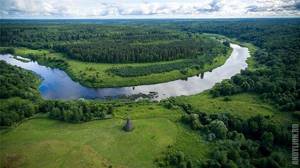
Ugra National Park is one of the most beautiful places in the Moscow region
On a note. You can learn more about the rules for staying in the park and the paid services provided on the website www.parkugra.ru. On this official resource you can also find out the latest news about the park, get acquainted with the map and diagram of this conservation zone, and ask the administration any question you have.
Features of fishing on the Ugra River
Geographically, the historical river is located in such a way that it is the natural defense of Moscow; it was the Ugra that stood in the way of Napoleon’s troops to the capital of Russia. The banks of the Ugra are famous for the military exploits of many Russians.
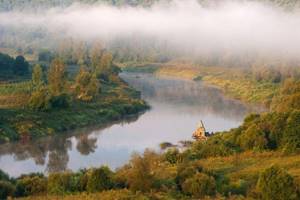
Its huge area is surrounded by pristine forests, and with the onset of summer, truly picturesque landscapes open up. There are sandy beaches in the lower reaches of the Ugra. The beautiful river attracts lovers of fishing and hunting, kayaking and rafting, and tourists with tents. The length of the river is hundreds of kilometers, and its sandy banks attract avid fishermen from all over Russia. True, within the national park this pleasure will not be free; you will need to pay a little or look for wild places. Not only local residents, but also a huge number of citizens from other cities come to fish in the Ugra.
Variety of fishing
The Ugra is rightfully considered the purest of the rivers in the entire central part of the country; its waters are constantly renewed by numerous tributaries flowing into it.
The Ugra is distinguished by a variety of fish species; it is home to silver bream, bream, pike and many other types of commercial fish. In the lower reaches of the river, a fisherman may be lucky to catch sterlet, catfish, and pike perch. The most difficult task here is not catching fish, but finding large specimens.
Each species has different fishing tricks. Almost all fish are caught with a worm, and pike can be caught with a spoon or live bait. Pike is a nocturnal fish; during the day it basks in the upper layers of water, and goes hunting after sunset or at the beginning of dawn. In spring, the asp bites well on the cockchafer. At the end of summer, the chub prefers a live grasshopper as bait. It is better to store the catch in cages or on kukans, since the fish can be stolen by otters and muskrats, which live there in sufficient numbers.
Fishing season
At the beginning of autumn, it is best to catch fish using a spinning rod, rafting on a rubber boat down the calm current of the Ugra. You can also enjoy the quiet river flow while floating along the reeds. In winter, you can catch fish with bloodworms and worms, pike with live bait, and perch with spoons. The Ugra has been covered with ice since the end of November. In spring, fishermen catch pike and asp at night. July is the best time for fishing - due to the absence of floods, the water level becomes slightly below normal, which forces the fish to stay closer to the surface. The summer season is favorable for spearfishing, when the water is most transparent.
Fishing bases
There are a sufficient number of fishing bases along the entire Ugra, among which the most visited and popular among fishermen and tourists are the following:
- fishing village “Golden Hook” (Kaluga region, Dzerzhinsky district, 12 km from the city of Kondrovo);
- recreation center "Rudnya Khutor" (Kaluga region, Dzerzhinsky district, Rudnya village);
- recreation center "Gnezdo" (Kaluga region, Yukhnovsky district, 11 km from the city of Yukhnov);
- recreation center “Four Seasons” (Kaluga region, Dzerzhinsky district, Luzhnoe village);
- recreation center "Khutor Rudnya" (Kaluga region, Dzerzhinsky district, Rudnya village).
The cost of living in guest houses at fishing bases ranges from 800-1,500 to 10,000-15,000 rubles.
***
Thus, the Ugra is a relatively small river flowing not far from Moscow, very popular among fishermen of the metropolis. Many of them prefer this small picturesque river to the paid trout and carp ponds teeming with fish. This popularity of the watercourse is explained by its clean and transparent water, the very beautiful nature of the coastal zone, and the large species diversity of fish living in the river depths.
